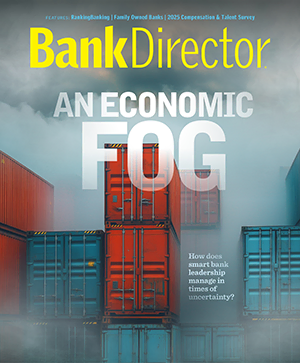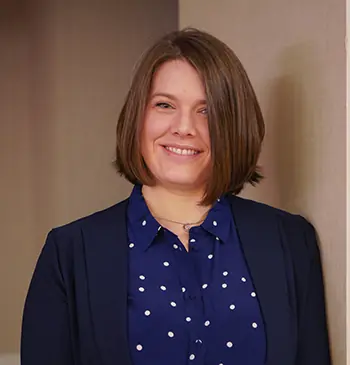Laura Alix is the Director of Research at Bank Director, where she collaborates on strategic research for bank directors and senior executives, including Bank Director’s annual surveys. She also writes for BankDirector.com and edits online video content. Laura is particularly interested in workforce management and retention strategies, environmental, social and governance issues, and fraud. She has previously covered national and regional banks for American Banker and community banks and credit unions for Banker & Tradesman. Based in Boston, she has a bachelor’s degree from the University of Connecticut and a master’s degree from CUNY Brooklyn College.

How Some Banks Get Employees Thinking Like an Owner
Employee stock ownership plans can be a tool to not only retain talent but also promote engagement with the job.
For many community banks, attracting and retaining talent can be tough. For some banks, employee stock ownership plans are a valuable tool not only for keeping long-term employees, but also for keeping them engaged.
“You take much better care of a car you own than a car you rent,” says Nan Poppen, chief human resources officer at Fishback Financial Corp. in Brookings, South Dakota. “If you’re an owner, you are going to be more engaged in what you’re doing because you see the impact of it. If you’re in the ESOP, more years than not, you’re getting a dividend.”
An employee stock ownership plan, ESOP for short, is a type of retirement plan, and because of that, the plan is governed by certain rules, says Ed Renenger, cochair of the ESOP group with the law firm Stevens & Lee. Like other retirement plans, ESOPs are regulated under the Employee Retirement Income Security Act, for example. According to the nonprofit National Center for Employee Ownership, there were 6,548 ESOPs across the United States at the end of 2022, the latest year for which it had data available. Banks represented 447 of those plans, the center says.
Sean-Tamba Matthew, a shareholder at Stevens & Lee, sees interest in ESOPs growing across the board. One example is a piece of bipartisan legislation, introduced in late April, that would encourage S corporations to form ESOPs.
Many companies that pursue employee stock ownership are motivated by the idea of being able to leave some kind of a legacy for the employees who helped them build the enterprise. An ESOP is essentially a trust that holds shares in the company for its employees, who earn shares over time based on factors such as salary or seniority. This vehicle allows participating employees to accumulate an ownership stake as the company grows; they receive distributions from the plan when they retire or leave the company.
“Many of these owners are of the mindset that, we’ve had these employees build this business with us over the years, and we want to give them some opportunity to benefit from the value that business generates from the ownership perspective,” Matthew says.
For firms in the manufacturing, construction, architecture and engineering fields, an ESOP can be part of a succession planning strategy, according to Renenger, who is also CEO of SES ESOP, Stevens & Lee’s ESOP consulting business. For banks, in particular, some level of employee ownership can also help to protect the organization from hostile takeover attempts by activist shareholders, he adds.
It can also be a valuable tool for employee retention and motivation. Fishback Financial’s $4.8 billion-subsidiary First Bank & Trust has offered an ESOP since 2010, Poppen says. Just under 10% of the company is owned by employees today, and the plan is available to all staff members in the first payroll of the next quarter after their hire date.
“When [employees] continue to see their ESOP go up, it’s really hard to walk away and go to a company that’s giving you a 7% match, but it’s in the stock market and the ESOP is outperforming the S&P,” Poppen says.
FirstBank Holding Co., in Lakewood, Colorado, has offered an ESOP since 1976, says Chief People Officer Shannon Jones. The $28 billion holding company for FirstBank contributes 4% of an employee’s salary into the ESOP, in addition to 4% into their 401(k), once that employee has been with the company for a minimum of one year and worked at least 1,000 hours.
The ESOP has been an attractive component of the overall compensation package, and Jones believes it’s a strong contributing factor in employee tenure. Thirty-five percent of FirstBank’s employees have been with the company for a decade or longer. “When people are here, they want to stay here long term,” she says.
Setting up an ESOP entails preparing a plan document and deciding how much of the company should be held in the plan. The bank also needs to hire a third-party trustee to manage the plan. Finally, its stock must be evaluated regularly by an independent party; Fishback Financial does this twice a year, Poppen says.
Banks should be aware that an ESOP may have a slightly negative impact on regulatory capital ratios and a slightly positive impact on earnings per share, Renenger says. For that reason, it’s important to model out the potential effect of the plan before actually putting it into place.
Education is an important component of a successful ESOP, says Jones. This means not only consistent and transparent communication about the company’s performance, goals and projections, but also tailoring that communication for its audience. Executives may understand those details more intimately than personal bankers or call center staff, for instance, but a successful program means that everybody knows at least the same fundamental details of what’s going on.
First Bank & Trust has designated April as its own internal ESOP celebration month, Poppen says. The company hosts activities and prize giveaways as a means of creating awareness of the ESOP and encouraging employees to learn more about it.
Participants in a plan may be employee-owners, but that does not mean they get to dictate managerial decisions, says Matthew. As employee-owners, they can vote periodically on certain fundamental corporate events, such as a merger or recapitalization, but they don’t have a say over the bank’s day-to-day operations.
Still, having an ownership stake for employees at all levels of the organization contributes to a culture where workers may think a little bit more carefully about how small decisions could affect the bottom line. “When you have a financial stake in the company, you care about the performance of the company,” Jones says. “It has helped us to create this culture of, ‘I have an ownership stake. If the company does well, that benefits me.’”


